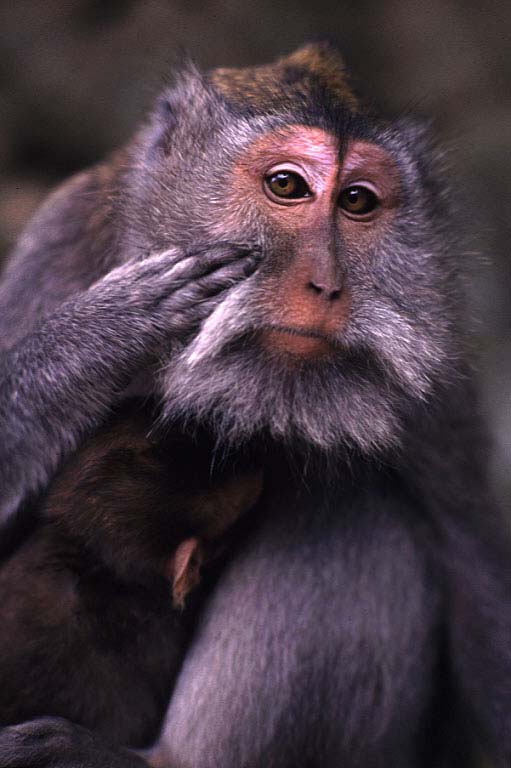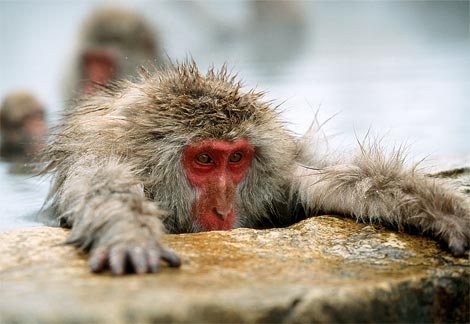Red-Faced Laughing Cryptid Monkeys
Posted by: Loren Coleman on February 12th, 2008

Are the reports of a strange new monkey related to Macaca fascicularis, pictured above? Or are they more clearly aligned with Japanese macaques? Are they a new species, as yet undiscovered? Or have exotic pet traders released some rare snow monkeys from Japan in the Philippines?
A group of red-faced monkeys that can mimic human laughter has been sighted in the mountain ranges of Sal-dab, a sacred mountain in Northern Mindanao, The STAR learned recently.
The monkey that mimics human voice is known to natives as Uma-ay and is believed to bring a curse on whoever sees it.
According to local folklore, whoever sees the creature will lose his way in the jungle or may encounter misfortune, accident or even death along the way.
The monkey, which is not included in the list of newly discovered animal species of the Department of Environment and Natural Resources (DENR), lives in high trees and subsists on fruits of wild trees in the forest.
The DENR Protected and Wildlife Bureau (PAWB) has reported sighting 14 new animal species since 1998.
Most of the creatures, however, were of the rat and bat species.
A tribal trapper interviewed by The STAR last year said the Uma-ay looks human because they do not have hair on their faces and can mimic the human voice. They grow up to the size of the native monkeys in the area.
“The laugh of an Uma-ay is an ominous sign, it means misfortune or even death,” the tribal hunter said in the Hiliga-onon dialect.
The hunter declined to name the location of the place where the Uma-ay can be found but said it is sacred ground where tribal elders offer sacrifices and perform yearly rituals to appease their gods.
Aside from the Uma-ay, the tribal folk also mentioned that they sighted an unnamed feathered bird that has mammalâs hair.
Just like the Uma-ay, the bird also mimics the human voice but its favorite sound is the cry of a newborn baby.
The natives call the creature Ukang (owl) or gulus (ghost). This nocturnal bird is often heard making noise at night but only a few elders have actually seen it.
Tribe members believe that the Uma-ay mimics the human voice to drive away the Kalumbata (monkey-eating eagle), which regularly hover in the area in search for food.
It is said that Uma-ays would simultaneously sound their laughter to confuse the marauding eagles.“Laughing, red-faced monkeys spotted in Mindanao wild”, by Perseus Echeminada, The Philippine Star, February 12, 2008,
Chad Arment, author of Boss Snakes and Cryptozoology: Science and Speculation, has this to say about these ethnoknown reports: “Regarding the primates noted,…Mindanao is home to one known species of primate, the crab-eating macaque, Macaca fascicularis, and it should be fairly common there from what I’ve seen. It does not, however, have the bright red-face that you might see in, for example, the Japanese macaques — at least not in any photographs I’ve seen. Most descriptions of the macaques on Mindanao are of brownish or gray coloration all over. So, it seems possible that the red-faced monkeys here could be a variant. Whether they’re a possible new species, I don’t think can be speculated without either better descriptions as an ethnoknown, or a specimen. And, of course, there’s mention of a bird with “hair,” but there’s a bit too much folklore and too little description to be overly confident in placing that as a cryptid.”

Another photograph of the crab-eating macaque (above) Macaca fascicularis.

The Japanese snow monkey or Japanese macaque (Macaca fuscata) does display a typical red-face.
About Loren Coleman
Loren Coleman is one of the world’s leading cryptozoologists, some say “the” leading living cryptozoologist. Certainly, he is acknowledged as the current living American researcher and writer who has most popularized cryptozoology in the late 20th and early 21st centuries.
Starting his fieldwork and investigations in 1960, after traveling and trekking extensively in pursuit of cryptozoological mysteries, Coleman began writing to share his experiences in 1969. An honorary member of Ivan T. Sanderson’s Society for the Investigation of the Unexplained in the 1970s, Coleman has been bestowed with similar honorary memberships of the North Idaho College Cryptozoology Club in 1983, and in subsequent years, that of the British Columbia Scientific Cryptozoology Club, CryptoSafari International, and other international organizations. He was also a Life Member and Benefactor of the International Society of Cryptozoology (now-defunct).
Loren Coleman’s daily blog, as a member of the Cryptomundo Team, served as an ongoing avenue of communication for the ever-growing body of cryptozoo news from 2005 through 2013. He returned as an infrequent contributor beginning Halloween week of 2015.
Coleman is the founder in 2003, and current director of the International Cryptozoology Museum in Portland, Maine.










Never bet against the ethnoknown, what I say.
“Normal” explanations have their place. But there’s too much evidence that we simply Overlook Stuff for me to say, out of hand, that that’s it.
of course the descriptions are full of folklore, that’s what tribal people do. They teach the young about the animals living around them adding a few things here and there to make them stand out. By dismissing any one of those critters described above would be doing the same thing as most explorers did throughout history. The bird with hair sounds similar to a kiwi (I don’t know too many birds looking like they have hair). I will believe the hunter. He knows the jungle there. He has to. Besides the Philippines are known for some oddities. In WWII one of my uncles helped in the birthing process of a baby that had a tail. The tribe that hid him from the Japanese had longer than normal tail bones. So, in my book, anything is possible there.
It just proves the old adage, that monkeys are the funniest people.
I would also display a typical red face, if I were inside that almost-boiling water! 😉
RED_PILL_JUNKIE:
So true, so true!!!
Never dismiss native folklore.
What sort of monkeys can mimic the human voice/laugh? Are there any known species that do that, or is this part of the folklore of this cryptid only?
I did a quick Google but I didn’t find anything. It would be great if this were yet another cryptid animal finally recognized by scientific zoology
I suppose that it -would- be hard to find your way in the jungle if you are rolling around on the jungle floor, laughing. Laughter is contagious.
Maybe the Japanese Snow Monkeys are snowbirds? 🙂
Well, as someone with experience with Japanese macaques, I might as well throw in my two cents here. It’s hard to say what these monkeys could be with the scant physical description given, but as far as Japanese macaques are concerned, I do have some thoughts.
First, here’s why I think these might NOT be Japanese macaques. To start, while some may exhibit fairly red faces, I wouldn’t go as far as to say that they typically have a “bright red face”. The coloration of their faces actually tends more towards a pinkish hue, although of course there is individual variation. A consistent description of a “bright red” face to me just does not indicate the most typical coloration for this species, although I’ll admit that one person’s pink could be another’s red, and witness perception could account for this.
Another thing I find doesn’t fit typical macaque behavior is the claim that these mystery monkeys live high in trees and mostly eat tree fruit. I don’t know if this is where they are supposed to solely live, but I get that feeling from the article. Japanese macaques, in fact, could be called “semi-terrestrial” and spend a good deal of time on the ground as well as in trees. Interestingly, it is the females that spend more time in the trees and males that spend more time on the ground. Regardless, they are not strictly arboreal animals. As to their diet, Japanese macaques are not specialized or finicky eaters at all, and will eat an incredible variety of foods, from fruit to roots dug up from the ground, anything that they can get their hands on really. Considering that their diet is so diverse, the description of these mystery monkeys subsisting on fruit high up in the trees doesn’t match up. Of course I have no way of knowing from the description given if these mystery monkeys eat ONLY fruit way up in the trees, but I can say that would likely not be all a Japanese macaque would be eating.
On the other hand, Japanese macaques are very hardy animals and can survive quite well in a range of climates and environments. They can inhabit anywhere from subtropical forests to the freezing temperatures of Hokkaido and endure wild seasonal temperature swings quite well. Add that adaptability to their tendency to eat just about anything, and I think if some were to get loose in the Philippines I have no doubt that they would flourish there. Also, macaques are quite often kept as pets in Japan and are popular as performing animals. I can easily imagine some finding their way to the Philippines through either the pet trade from the not so distant Japan, or from escaped performing animals brought over to give shows.
All in all, from what I see in this article, there just isn’t enough information for me to really make any kind of serious call on the possible identity of the mystery monkeys. The article’s description of their behavior and morphology is too brief to do much with. For the reasons I have given, I have my doubts that the mystery animals are Japanese macaques, but I will grant that this is a possibility.
Oh, I forgot to mention this too. While Japanese macaques do use a range of vocalizations to communicate, there are none that I feel really match up well to sounding like the mimicry of a human laugh. Again, witness perception or local folklore could play a role here, but “human laughter” is not how I would describe any of a Japanese macaque’s vocalizations. If I could hear a recording of the alleged monkey’s calls, I could tell you right away if it was a Japanese macaque. As it is, a sound like human laughter doesn’t really fit.
My 2 cents here are that it is unlikely that these mystery monkeys would be escaped Japanese Macaques, considering the rather elaborate folklore that has been developed around them. That folklore to me suggests an animal that has been ethnoknown for quite some time, long enough for traditions to develop concerning it.
As for the hairy bird, I hadn’t thought about the Kiwi. What first came to my mind was the Nightjar (Sometimes called a, wait-for-it…Goatsucker), which possess rictal bristles which project from the mouth. Oddly enough, Nightjars are cryptids themselves in Jamaica and Cuba, where 2 supposedly extinct endemic species are rumoured to survive.